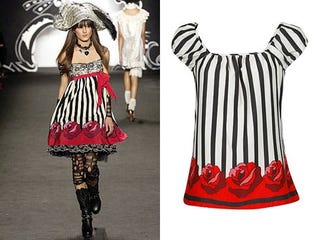 |
| Left: Anna Sui 2011 Right: Forever 21 Forever 21 has been sued over 50 times & has never lost a case |
Somes things you could try if you suspect a copycat:
Contact the other designer. If it truly was a coincidence then that designer may be thinking that YOU copied HIS design and has just not said anything. If you feel comfortable about it, you could try a polite, private and non-accusatory email. Reaching out to the other artist could lead to a collaboration or a mutually beneficial business relationship, especially since your design aesthetics seem to be so in tune. Tread carefully though. If the other designer responds defensively just let it go. An online shouting match could be at best unpleasant and at worst damaging to your reputation throughout social media and industry networking circles.
Sell the Pattern. If you have sold even one of your designs you have in essence already sold the pattern. Anyone can deconstruct your creation and copy it. Home sewers, knitters and crocheters are great customers for patterns. Put your pattern up for sale online alongside the merchandise to appeal to different market segments. You can offer the pattern as a pdf file for automatic download on many of the more popular online venues. One place to offer a pattern or other merchandise for sale is on etsy.com. Visit Fettuccinetube for basic patternmaking classes.
Offer your design to a brick and mortar shop. Find small, reputable boutiques in your area and offer a few of your pieces wholesale or on consignment. This is not easy, it is basically door-to-door sales. You could email the boutique if they happen to have a website. Here are a few other tips: Getting your Line into Boutiques.
Create your own Textiles. Maybe someone can copy your clothing pattern but it it much more difficult to copy your textile. This entails creating a fabric of your own. For example buying a plain cotton fabric and dying or painting your own personal design onto it. You could also learn screenprinting and copyright your own original screenprint image to print over and over onto your designs. If your copycat tries to use the same image you will have some legal leverage.
Keep improving. This is a challenge to yourself to innovate and make your designs more difficult to copy, your marketing and advertising more impressive, your message more powerful. This will not stop the copying altogether but - unless the copycat is a huge clothing brand - it will become more and more difficult for others to keep up with your progress. Be sure to copyright any photos, artwork or trademark any slogans in your advertising. Infringement on these things is easier to prove if your copycat tries to use them.
Bear in mind that whether we realize it or not, inspiration in design always comes from other things. In a way everything is copied however it is usually translated through each designer's unique vision. To avoid being accused of copying yourself it is best to get inspiration from things other than clothes such as art, music, nature, architecture etc....
See an interesting perspective from a pair of independent clothing designers who were the guilty party in a copycat situation. Read how in hindsight they feel that getting caught helped them improve their brand.
Create your own Textiles. Maybe someone can copy your clothing pattern but it it much more difficult to copy your textile. This entails creating a fabric of your own. For example buying a plain cotton fabric and dying or painting your own personal design onto it. You could also learn screenprinting and copyright your own original screenprint image to print over and over onto your designs. If your copycat tries to use the same image you will have some legal leverage.
Keep improving. This is a challenge to yourself to innovate and make your designs more difficult to copy, your marketing and advertising more impressive, your message more powerful. This will not stop the copying altogether but - unless the copycat is a huge clothing brand - it will become more and more difficult for others to keep up with your progress. Be sure to copyright any photos, artwork or trademark any slogans in your advertising. Infringement on these things is easier to prove if your copycat tries to use them.
Bear in mind that whether we realize it or not, inspiration in design always comes from other things. In a way everything is copied however it is usually translated through each designer's unique vision. To avoid being accused of copying yourself it is best to get inspiration from things other than clothes such as art, music, nature, architecture etc....
See an interesting perspective from a pair of independent clothing designers who were the guilty party in a copycat situation. Read how in hindsight they feel that getting caught helped them improve their brand.

1 comment:
replica bags online shopping india replica bags nyc 9a replica bags
Post a Comment